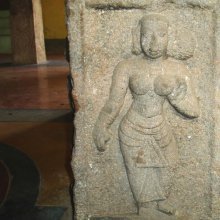Bharatanatyam, Bharata-natyam: 4 definitions
Introduction:
Bharatanatyam means something in Hinduism, Sanskrit, the history of ancient India. If you want to know the exact meaning, history, etymology or English translation of this term then check out the descriptions on this page. Add your comment or reference to a book if you want to contribute to this summary article.
Images (photo gallery)
In Hinduism
Nirukta (Sanskrit etymology)
Source: Shodhganga: The significance of the mūla-beras (nirukta)Bharatanatyam is said to be the dance of Bhārat, which is India. Some scholars define Bharatanatyam as the dance that comprises bhā (bhāva–expressions), rā (rāga–melody), tā (tāla–rhythm) and m (śruti–pitch). The term ‘Bharatanatyam’ is derived from the word “Bharata”, the author of the treatise Nāṭyaśāstra. The prefix Bharata is commonly explained as an acronym composed of the first letters of bhāva, rāga, and tāla; and the suffix nāṭyam in Tamil means dance.
Nirukta (निरुक्त) or “etymology” refers to the linguistic analysis of the Sanskrit language. This branch studies the interpretation of common and ancient words and explains them in their proper context. Nirukta is one of the six additional sciences (vedanga) to be studied along with the Vedas.
Natyashastra (theatrics and dramaturgy)
Source: Shodhganga: The significance of the mūla-beras (natya)Bharatanatyam forms a major tradition of performing arts in India.—The classical dance form of Bharatanatyam appears as a subtle synthesis of philosophy, religion, sculpture, dance, music, and literature. It gathers all these strands and sets them in motion. Bharatanatyam includes ethics, aesthetics, and social reality in it. To quote Prathibha Prahahlad, “Bharatanatyam is by fact a socioaesthetic phenomenon, embedded in Hinduism that detaches beyond dance proper”.
Bharatanatyam is in essence an offering to the Almighty through mime, gesture, and the rhythm of the dancing feet,” says Manjula Narasimhan. Bharatanatyam has a grammar of its own, with tāṇḍava and lāsya as important parts. In general, the main elements of Bharatanatyam are nṛtta and nṛtya. The nṛtta sequences are based on the aḍavu system and the nṛtya sequences are based on the abhinaya portions.
Source: Shodhganga: Elements of Art and Architecture in the Trtiyakhanda of the Visnudharmottarapurana (natya)Bharatanatyam refers to one of the eight kinds of classical dance form of India recognised by Sangeet Natak Academy. The classical dance forms of India have numerous elements through which a performer presents a particular dance form properly. [...] The classical dance forms [such as Bharatanāṭyam] are fully based on the Abhinayadarpaṇa which has resemblances with the Nāṭyaśāstra. [...] The gestures and postures of Dance as found in the Viṣṇudharmottarapurāṇa as almost same with the Classical Dance forms [such as Bharatanāṭyam].

Natyashastra (नाट्यशास्त्र, nāṭyaśāstra) refers to both the ancient Indian tradition (shastra) of performing arts, (natya—theatrics, drama, dance, music), as well as the name of a Sanskrit work dealing with these subjects. It also teaches the rules for composing Dramatic plays (nataka), construction and performance of Theater, and Poetic works (kavya).
India history and geography
Source: Shodhganga: The significance of the mūla-beras (history)Bharatanatyam is special to Tamilnadu. It was known by several names such as kūttu, satir, cilampam, chinna-melam and dāsiāṭṭam. Today the term “Bharatanatyam” has replaced satir. The word “Bharatanatyam” consists of a noun nāṭya and an adjective bharata. Nāṭya is the representation of rasa through the four-fold modes of abhinaya or acting. They are: aesthetic expression (sāttvika); gestural expression (āṅgika); vocal and literary expression (vācika); and, expression through costumes, make-up and stagecraft (āhārya). Bharatanatyam is said to be a science amongst the performing arts. It places equal emphasis on the different aspects that go to make dance composite, namely bhāva (expression), rāga (melody), and tāla (rhythm).

The history of India traces the identification of countries, villages, towns and other regions of India, as well as mythology, zoology, royal dynasties, rulers, tribes, local festivities and traditions and regional languages. Ancient India enjoyed religious freedom and encourages the path of Dharma, a concept common to Buddhism, Hinduism, and Jainism.
See also (Relevant definitions)
Partial matches: Natyam, Bharata.
Full-text (+88): Cilampam, Satir, Dasiattam, Chinna-melam, Sthanaka, Alidhasana, Pratyalidha, Ketu, Pratyalidhasana, Abhinayadarpana, Mohiniyattam, Parshva, Kathakali, Abhinayanavanita, Vibhava, Aindra, Rahu, Nritta, Anubhava, Kati.
Relevant text
Search found 4 books and stories containing Bharatanatyam, Bharata-natyam, Bharatanāṭyam, Bharata-nāṭyam; (plurals include: Bharatanatyams, natyams, Bharatanāṭyams, nāṭyams). You can also click to the full overview containing English textual excerpts. Below are direct links for the most relevant articles:
Vishnudharmottara Purana (Art and Architecture) (by Bhagyashree Sarma)
2. The Viṣṇudharmottara-purāṇa and the Indian Classical Dances < [Chapter 6 - Modern Relevance of Different Art Forms and Architecture]
Mohiniyattam < [January 1970]
Rukmini Devi < [January – March, 1986]
Swathi Thirunal < [April – June 1992]
Gati in Theory and Practice (by Dr. Sujatha Mohan)
Research Methodology < [Introduction]
Chapterisation—Thesis structure < [Introduction]
Middle Chola Temples (by S. R. Balasubrahmanyam)
Temples in Malur < [Chapter II - Temples of Rajaraja I’s Time]
